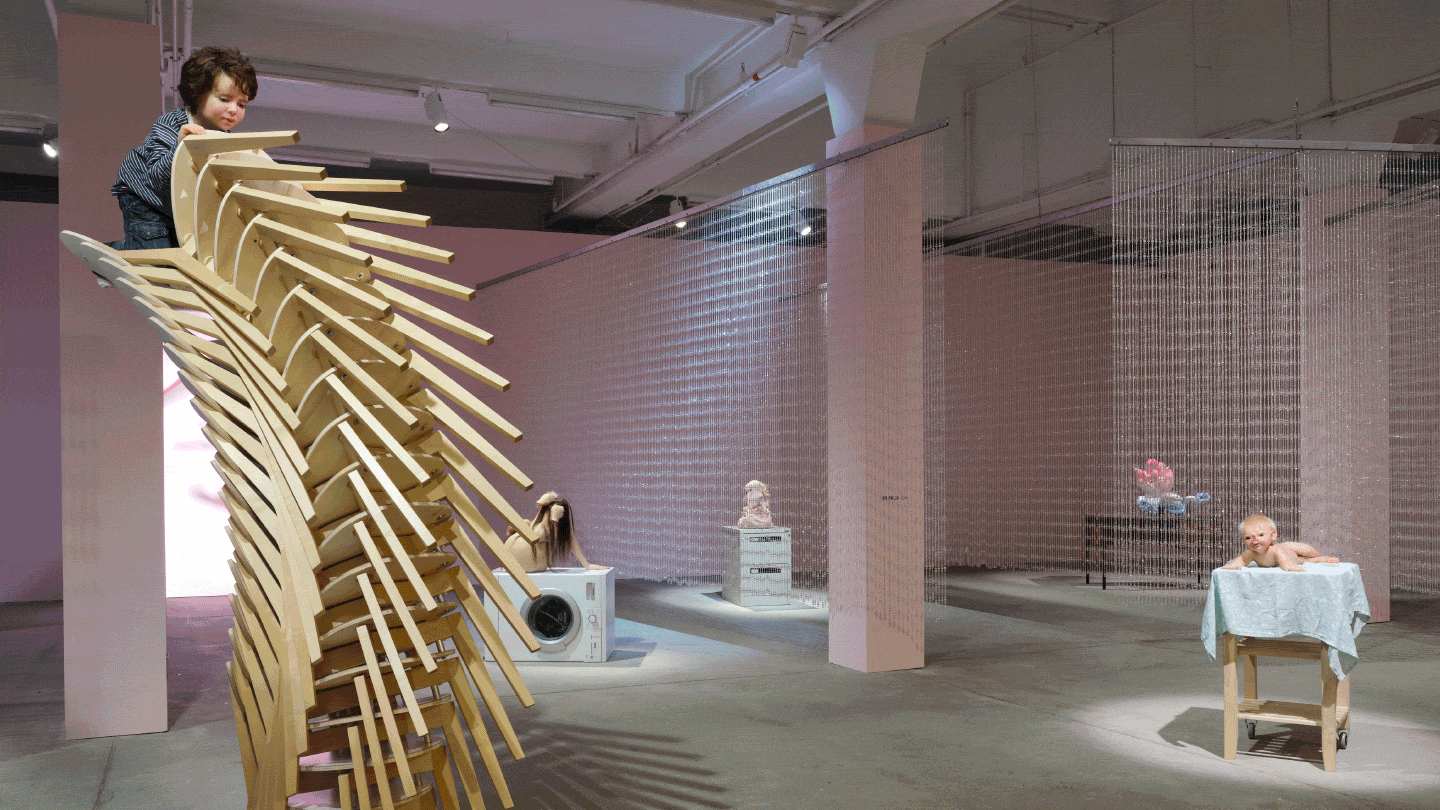May 24–September 3, 2023
A little boy is in limbo, perched high on top of a stack of eighteen chairs in The Observer: smiling fearlessly, peering curiously over the edge, admiring the world from above. The viewer might speculate if this daring attempt does not lead to imminent disaster. And from this precarious balance between testing a structure to the limit, where one breathes in the wonders of freedom and achievement, and on the opposite end, the impending danger of total collapse, the observer could easily read metaphors for the world today, where on many fronts—ecological, scientific, technological—humanity’s capacity for good and for ill threatens to outpace our ability to moderate our rashest impulses. Massive anthropogenic climate change. Widespread extinction of flora and fauna. Overpopulation. New life-changing science and technology, which also seem poised to upend societies. All these re-define how and if we can live together.
With her works exhibited globally for the last 30 years, the Australian artist Patricia Piccinini has created an oeuvre that revolves around the unintended consequences of progress, raising questions about science and progress. In the Tai Kwun Contemporary exhibition HOPE—Patricia Piccinini, the artist’s “hyper-surrealistic” works, hovering between wonder, horror, and comedy, serve to ensnare viewers’ attention: visually engaging them but also leaving them with challenging questions that linger slowly and persistently, through an entire exhibition replete with such contradictions.
Yet it is a mistake to think that her works represent horrific scenarios of unintended consequences, even if they are sometimes seen that way. Her detailed, fantastic sculptures serve not as props of a future dystopia; rather, they are works of hope, staring back at us, projecting the wish and fact that there is, or could be, epiphany and care, that there is an interdependence or co-dependency that should be rewarded with love. Many of her works, for instance, refer to chimeras, or admixtures of different creatures. If we look closer at Picccinini’s sculptures we often see references to mythological and (art) historical iconography. We see works that are even named after Greek mythology, or adapted from paintings. There must be something deeply human, with stories about loving and caring about the other—chimeras, aliens and maybe also monsters—from ancient times to the present. These “otherly” figures are not only familiar because of their size and skin colors but also because we grew up with them in children books, mangas, or even museum collections; they are, moreover, fascinating for us. The human and animal connection seems to be deeply ingrained in history.
Patricia Piccinini works touch us, sometimes in loving ways but at other times also in uncanny and scary ways: because they could be real, because they are of natural size, colour, and have many features that we know from the contexts of humans, animals, or plants. They are of different ages: babies, children, grown-ups, and older creatures. They smile, they hug, they care for each other. And here is where this essential idea of hope starts: that these figures are not alone, that they very well understand their differences, their weaknesses, but also their co-dependencies and mutual reliance. The beauty of empathy, of caring, of understanding and tolerating differences. It’s not the survival of the fittest but the fact that the most understanding ones live together which Patricia Piccinini emphasises.
Over the course of the exhibition, Tai Kwun Contemporary will host a wide range of public programming and educational events that dive into the deeper themes raised by Piccinini’s works, including her references to mythology and iconography, as well as broader ethical questions about science, progress, and ethics. These include Patricia Piccinini After Hours, a series of intimate conversations with special guests and speakers who will be discussing topics such as ethics and morality in biotech and genetics, the climate crisis and extinction, and human creations of life. Patricia Piccinini’s Choice meanwhile will screen a series of films as chosen by the artist, including The Rocky Horror Picture Show, Frankenstein, and The Fly. Of particular interest to families with children will be the Family Day events held throughout the run of the exhibition. Finally, HOPE—Patricia Piccinini also includes a special series of guided tours presented in collaboration with art and curatorial researcher Mankit Lai, artist Michelle Lee Ho Wing, artist and curator Eunice Tsang, guest curator and writer Chris Wan Feng, artist Ice Wong Kei Suet, artist and educator Morgan Wong, and architectural designer Human Wu.
Artist: Patricia Piccinini
Curator: Tobias Berger
Presented by Tai Kwun Contemporary.


